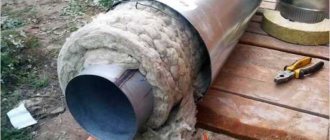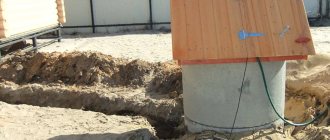To prevent the water in the well from freezing, it should be insulated. Almost all areas of country houses are equipped with a well, which ensures uninterrupted water supply. The cold winter months are risky as the casing and supply pipe may freeze. To ensure that the water supply does not stop, the home owner must know at what temperature the water freezes outside, as well as how to insulate the well and prevent freezing. You can do this yourself using available materials.
Ways to insulate an outdoor water source
When choosing materials for insulating a well, it is necessary to take into account the climatic conditions of the area in which the well is located. The choice of materials is directly influenced by the level at which groundwater is located. If the area has a mild climate, you can use sawdust, straw or high-moor peat to insulate the well.
Thermal insulation material can be purchased at any hardware store
To insulate a well column, it is necessary to surround the box into which the insulation is poured.
The thermal insulator must be protected from moisture, otherwise it will lose its thermal insulation properties. More severe climates require the selection of a material with high technical characteristics. The well can be insulated with polystyrene, basalt wool, foam insulation, glass wool, and polystyrene foam.
How to insulate a well:
- Cover the riser with a metal mesh with small cells.
- Equip the structure with a metal casing, not forgetting to leave free space to place the insulation.
- Fill with sawdust or the material that was chosen for insulation.
- The valve should be equipped with a tin tray, which should extend beyond the metal casing. It is important to maintain a slope that prevents moisture from entering.
For high-quality insulation, you can use an additional heating system. To do this, the well must be equipped with a small heater and a floating sensor that monitors freezing. The sensor will work as soon as an ice crust forms on the surface of the water.
Classification of pumps by source of intake and principle of operation ↑
First, let's decide on the type of pump. They are classified according to the source of the fence:
- superficial;
- deep (submersible),
according to the operating principle:
- vibration;
- centrifugal.
Let's consider each option separately.
From the name it follows that such units are not immersed in water, but are located on the surface. If distance allows, it can be installed indoors or in a barn. To draw water from a well, a hose is used, one end of which is attached to a pump and the other is lowered into the water.
Some lightweight options can be installed on the surface of the water using a special float. The float can be made of foam, this will allow the unit to be in close proximity to the water without touching its surface. But more often, surface pumps are installed at a distance from the well. The suction height of such devices reaches 8 meters.
The use of an ejector allows you to greatly increase the pump pressure
Where the depth of the well exceeds these readings, you have to resort to small tricks. One option would be to use an external ejector. It is lowered into the well along with the suction hose. Part of the water raised by the pump is pumped through an additional hose into the ejector, which leads to an increase in inlet pressure.
Surface pumps are easier to dismantle and maintain. They are not exposed to moisture and are not difficult to use. Another advantage is the relatively low cost. However, the suction height of a surface pump is significantly lower than that of a deep pump.
Where the water is below 8 meters, it is more advisable to use a deep well pump. They are also called submersible, as they are lowered directly into the water. The body of such devices is made of waterproof materials and is sealed. Therefore, the depth of the well in this case does not matter.
The market for submersible pumps is now very diverse and everyone can choose a device to suit their requirements.
High pressure allows you to get water from any depth, but prohibits bringing the pump closer than 1 meter to the bottom. If you lower the submersible pump for a well, the quality of the supplied water will deteriorate. Sand and mule from the bottom will begin to flow into the hose. Over time, this can lead to mechanism failure.
In this unit, an electromagnet drives a vibrator, which ensures the movement of water through the pipes. The vibration frequency of the piston in the hydraulic chamber is 100 times per second. Due to the translational movement of the piston, the process of suction and expulsion of liquid occurs.
Internal structure of the vibration pump “Rucheek” (click to enlarge)
The vibrator is equipped with a control valve, which ensures the movement of water in the pressure pipe. The passing water protects the structural parts from overheating. Therefore, running the pump “dry” leads to breakdown of the unit. The vibration pump can only be installed on the surface. If the mechanism is installed inside the well, it will simply destroy it.
When considering deep-well units, it is better to choose a centrifugal pump for a well. The main design detail of such a pump is one or more wheels. They are located inside the housing on a shaft and consist of paired disks connected by blades.
Centrifugal pump for well
During operation of the mechanism, the space between the blades is filled with water, which is subject to centrifugal force when the wheel rotates. This force creates an area of high pressure at the edges and low pressure in the center. The pressure difference between the outside and the center forces the fluid entering the wheels through the outlet pipe.
Now let’s decide: which pump is better for a well? A surface pump is capable of raising water to a height of up to 10 m. This is the case if the unit is located in close proximity to the well. And if it is removed, it is necessary to take into account the height difference between the dynamic water level and the pump, as well as pressure losses along the entire water main. Deep pumps have a number of advantages over surface pumps. Namely:
- noiselessness;
- easier mounting of the pump in the well;
- maximum depth of application;
- ease of installation;
- battery life.
Water passing through the pump cools its parts, which prevents the equipment from overheating. Submersible pumps are equipped with float switches, which automatically turn off the engine when the water level drops below a critical level. The only drawback of deep-well pumps is the difficulty of maintenance. When carrying out maintenance and repair activities, the unit must be removed from the well. Disassembling a sealed case is more difficult. To do this, it is advisable to call a specialist.
Measures to prevent freezing
Usually the well is located at a distance of several meters from the house. It can also be located in the basement, but even then care must be taken to ensure that the water in it does not freeze. Most often, water freezing occurs in the area called “ground-air”. Crystallization of water affects the air section of the pipe.
Experts call measures that help avoid water freezing passive and active.
Passive measures include the choice of material for the supply pipe. It must have thermal insulating properties. The pipe can be made of polyethylene, polypropylene or metal-plastic. It is highly undesirable for the pipes to be metal.
Do not knock on a frozen tap to avoid damaging it.
Passive measures:
- The diameter of the supply pipe must be large.
- The depth of the trench should be equal to the average depth of soil freezing in a particular area.
- The pipe must slope correctly towards the well.
- A prerequisite is insulation of the pipe.
The active method involves inspecting the underground area and its mouth and removing ice plugs. The best active protection is the use of a heating cable. If the owners are in the house during severe frosts, it is necessary to monitor the drainage of water several times a day.
Briefly about the main thing
Depending on the frequency of operation, there are the following ways to insulate a well on the street:
- Seasonal, when the well is not operated, but is simply drained and turned off for the winter.
- Periodic, when water is collected on weekends or once every few days. To maintain performance, heat-insulating materials and heaters are used.
- Constant, when the well is practically never idle, so the flow never stops for long. However, in cold weather, icing may begin. Therefore, professional insulation is required.
At the same time, 4 technologies are used for thermal insulation - using insulation, with a coffered structure, without it and with the installation of a heating cable. In most cases, combined methods are used. Thermal insulating materials are polystyrene foam, penoplex, polyethylene foam, mineral or glass wool, as well as penoizol, polyurethane foam and expanded clay. You can do the thermal insulation yourself, but it is better to entrust the job to a professional team.
Insulation of a well with a high groundwater level
The process of drilling a well is not difficult. It is more difficult to ensure its smooth operation, especially in the colder months. The winter period is the most difficult.
Excessively low temperatures can cause moisture in the upper soil layers to freeze.
The depth of the soil frost line may vary depending on the climatic conditions of a particular area. Problems with water supply can be avoided by first taking care of choosing the right thermal insulation technology. The well must be insulated before the first frost sets in.
How to install a caisson:
- Dig a pit around the well column.
- Equip the bottom of the pit with a gravel “cushion”. Fill it with concrete mortar.
- In the caisson, or rather, at its bottom, it is necessary to make a hole, the diameter of which will correspond to the casing pipe and the supply water supply.
- Cover the walls of the structure with insulation, on which waterproofing is laid.
- The side covering is made from a sand-cement mixture.
- The excavated soil is backfilled, then the caisson cover is installed.
To perform thermal insulation of pipes you do not need to spend a lot of money
An effective but expensive method of thermal insulation includes installing a cable equipped with an electric heater. It is worth noting that when choosing this method, you need to take into account that the thermal insulation material must withstand the high temperature of the heated cable. It is better to entrust cable laying to specialists.
Features of insulation installation
High-quality installation of insulation is a guarantee that the structure will serve reliably and efficiently. Depending on the chosen insulation option, installation work will differ. Wells and wells in the winter at the dacha require mandatory insulation, so we will consider the features of the foam insulation method.
Insulating a brick well with foam plastic
The easiest way to insulate a well is to use polystyrene foam or expanded polystyrene. The difference between materials is not only in price, but also in efficiency. It is recommended to use polystyrene foam or penoplex as insulation.
The principle of the work is to perform the following actions:
- Remove soil around the perimeter of the caisson to be able to place the insulation deeper.
- Measure the required size of polystyrene foam and then cut it. The thickness of expanded polystyrene depends on the region of residence, but the best option is 4-5 mm.
- You need to glue the cut sheets of polystyrene foam of the required size using special glue. To prevent the structure from falling apart in the future, it is recommended to use additional fasteners in the form of plastic mushrooms.
- Installation of fungi is carried out using a drill.
- After installing expanded polystyrene sheets around the perimeter, it is necessary to resort to the reinforcement procedure after 24 hours. For this purpose, there are also special adhesive compositions in the form of bulk materials.
- Reinforcement of the outer surface allows you to protect the insulation from external influences, as well as increase the efficiency of the structure.
Insulation of the outside of houses is carried out in a similar way. To save on this insulation option, you can line the outer wall of the caisson with polystyrene foam, and then fix it with improvised materials. This method of insulation will allow you to remove polystyrene foam in the summer.
Additional protection at the stage of installation work: how to insulate the cover
For wells with submersible pumps, the system is mothballed before long periods of downtime. To carry out this procedure, pipelines are laid with a slope towards the water source.
After the pump is turned off, it is removed from the installation, and the water returns by gravity to the well.
If this technique is used, it is important to ensure that there are no pockets where water would accumulate
It is known how the well is insulated, as well as what materials are used for the work, so it remains to understand the question of how to close the well. The top cover plays an important role, since the lack of insulation on the top cover leads to the system freezing. There are options for insulating the top cover:
- manufacturing the lid from special materials;
- insulation of the existing cover;
- production of covers from woodworking materials;
- covering the upper part of the caisson with insulating materials.
The best option is to make a cover from insulating materials. Foam or polystyrene foam is used as such material. However, to ensure structural strength, the foam cover must be covered on the outside with a protective layer. Galvanized or plastic is suitable as such a layer.
You can make a cover for a well from woodworking material, however, under the influence of water and sun, such a structure will not last long. Additional protection of the structure from weather factors will be required.
Another popular method of insulation is the use of polyurethane foam. The inner walls of the caisson are covered with polyurethane foam, which allows for not only a good degree of thermal conductivity, but also waterproofing.
Before carrying out work on installing well insulation, you need to pay special attention to factors such as the region of residence, as well as the depth of soil freezing. You need to worry about insulating the well in advance, since with the arrival of cold weather it is already difficult to carry out most construction work
Winter operation and preventive measures
Living in a dacha in winter is not constant. There is often a risk of water pipes freezing in severe frosts. That is why it is necessary to take care of the thermal insulation of the well in cold weather.
Installation of the caisson, downhole adapter and supply pipe occurs below the level at which freezing is possible.
To prevent pipes from freezing in winter, it is better to place them deep underground
The method of insulating a well or well is particularly influenced by the type of construction and hydrological characteristics. The water pipe must be laid below the level at which the soil freezes. Not only the well, but also the pipes should be insulated.
Prevention of freezing:
- Monitor the constant flow of water in the system.
- Pump the well for half an hour before water is supplied to the house.
To prevent the well from freezing, you need to monitor the renewal of water flow. Freezing most often occurs due to the fact that the well has not been used for a long time. That is why experts advise installing a heating cable. If the water does freeze, you can defrost it by piercing the hose, which is located below the freezing depth.
Country houses are most often equipped with an autonomous water supply system, which operates thanks to the presence of a well or borehole. In summer, there are no problems with water supply. But in winter, especially if the dacha is often empty, there is a risk that the water in the well and pipes will freeze. When insulating, you need to pay attention to how the primer freezes. The choice of material will depend on this. If the water does freeze, it will only be able to thaw if active measures are taken to defrost the well and pipes.
Installation of an insulated box
In regions with a mild climate and minor frosts, it is not necessary to install a caisson. The well head along with all the equipment is placed in an insulated box, which is opened if necessary. The protective structure can be built from wooden building materials or made of brick. The inside walls are covered with heat-insulating material. In addition to insulation, such a structure can also perform a decorative function if original design ideas are introduced into its design.
Insulation of a well in regions with a warm climate is carried out by building a small house in which equipment and pipework are hidden
Does the water well freeze in winter?
The water intake structure itself naturally cannot freeze.
But difficulties with operating wells in winter still arise. The fact is that water located in a well at a level above the soil freezing level can freeze. Therefore, to prepare a well for winter, it is important to analyze where and in what cases the water in the well may be above the soil freezing level.
Note. For the middle zone, it is generally accepted that the level of soil freezing is 1.8 - 2 meters. For other regions the value may vary. In addition, freezing can be deeper when temperatures drop significantly from average values and may depend on other factors.
Without caisson
Water supply equipment, filters and related electronics are located in the house or a separate room - this does not mean that the shaft does not need to be insulated. There are several ways to insulate a source without a caisson:
- Thermal protection of the mine shaft with wood chips or sawdust. The pipe is dug around its entire circumference to a depth of 2 - 2.5 meters. The width of the trench is 30 - 40 centimeters. Then a mesh with a large cell is wound to provide an air gap between the wall and the insulation. Next, the material (sawdust or peat) is gradually filled in. You cannot compact the insulation; it is better to let it stand for a while, and after shrinking, add more. A durable lid made of wood or metal is placed on top.
- Thermal insulation with mineral wool. They dig a trench in the same way and stretch the mesh. Then several layers of glass wool or mineral wool are wound onto the pipe. It is better to use a 5 cm thick mat. The final insulation layer is 35 cm.
- Insulation with liquid polyurethane foam is a little simpler. No need to wrap the mesh. A special device is simply lowered into the pit and polyurethane foam is sprayed layer by layer onto the surface of the pipe.
- Heating with electric cable. The principle is to use a special heating cable, which is tightly wound to the well pipe. A non-flammable film must be wrapped over the heating element and additional waterproofing is provided.
Can the water in the well itself be higher than the freezing depth of the soil?
In some places, water in aquifers is under excess pressure. This phenomenon is typical for aquiferous limestones, but can also occur on aquiferous sands. Wells drilled for such aquifers may go into self-flow mode or have a high static water level (i.e., the water surface in the absence of extraction may be at a shallow depth). Thus, we have 2 cases in which water in the well casing may end up at the depth of soil freezing:
- Well with self-discharge;
- Well with a high static level.
Each case has its own characteristics regarding freezing. For this reason, we will analyze the situations separately below.
Haven't drilled a well yet? We recommend reading on the topic:
- How to find out at what depth the water is in the area?
Tools and materials
Ready-made thermally insulated pipes are available for sale.
To properly insulate a well from the street, you need to prepare the following tools:
- roulette;
- construction tape and pencil;
- hacksaw for cutting insulation;
- liquid nails, self-tapping screws for attaching sheets of material to the caisson frame;
- shovel.
Additionally, the insulation itself should be prepared. The following materials are most often used:
- Glass wool or mineral wool. The cheapest options. Prone to deformation and moisture absorption. To use such insulation, you will have to create an additional protective durable casing over the materials. You should use cotton wool only in places where condensation or leaks are excluded. It is prohibited to use these types of insulation if the groundwater level is high on the site.
- Basalt fiber. Thanks to the foil coating, the material is considered convenient to use and has good thermal insulation characteristics.
- Expanded polystyrene or polystyrene foam. Can be used in the form of sheets or special cylinders. Both types of material are easy to cut, retain heat well, but are of interest to rodents. When using foam insulation, you need to make a special protective coating of cement and broken glass.
- Sprayed polyurethane foam. Easy to use. When using it, water pipes must be laid on expanded clay bedding.
- Thermal paint. Liquid heat insulator is expensive, but with its help you can treat the most inaccessible areas of the pipeline and equipment. If paint is used on metal parts, it additionally serves as protection against corrosion.
Can a self-damping well freeze in the winter cold?
It is impossible to give an unambiguous reflection here. It all depends on the degree and nature of self-outflow and the power of cold weather.
If a large volume of water under good pressure constantly comes out of the well, then the risk of water freezing in the casing shaft is minimal.
If self-flow is weak or periodic, then the risk of ice plug formation in the casing is high.
Why do you need a heating cable?
The heating cable is laid outside. You can lay it inside or outside the pipeline. The included electric cable prevents the pipes from icing up and heats the water. Heating wire can be wrapped around not only the pipeline, but also the caisson and the mouth with the tip.
Insulation on the street can be carried out with different types of electrical cables:
- resistive - supply heat with the same intensity;
- self-regulating - change the heating temperature.
The efficiency of self-regulating wires is higher because the intensity of heating of the sheath depends on the temperature of the water. By choosing this option, ineffective heat loss is reduced. In terms of price, self-regulating wires are not much more expensive than resistive wires. At the same time, they provide significant energy savings.
Typically, HDPE pipes are used to supply water to the house. The material has low thermal conductivity, so using the cable outside is less effective. When the wire is laid outside, it requires additional insulation. It protects the wire from exposure to groundwater and reduces excess heat loss.
Frequently asked questions regarding the operation of water wells in winter
Does the well freeze in the winter at the dacha?
It seems that the answer is obvious based on the above.
In addition to the factors listed in the article, the degree of insulation of the water intake structure should be taken into account. And you can get a complete answer to the question posed.
The well in the country house freezes in winter, what should I do?
There are two solutions:
- Insulate;
- Warm up.
Each of the solutions requires a separate article. We'll prepare them later.
Does the well freeze in winter if not in use?
A well with a low static water level cannot freeze.
Freezing of a well with a high static water level can be predicted with almost one hundred percent probability. By the way, the use of such wells can be considered as one of the options for protection against freezing.
For self-flowing wells, it is difficult to predict an unambiguous outcome.
The well is frozen - what to do?
First of all, you need to understand where exactly the well froze. As you can understand from the text of the article, there are several options.
After determining the location of freezing, it is necessary to analyze the possibility of heating or otherwise removing the ice plug.
More details on the topic here.
A little later in this article we will answer the following questions:
- How to pump water from a well in winter?
- What to do with a well in winter?
- How to insulate a well?
- How to use a well in winter?
- How to leave a well for the winter?
- The well is frozen, what should I do?
Source
Reading time: 4 min. 3k. Published 03/05/2019 Updated 03/03/2019
In suburban areas, owners often resort to drilling their own well. Due to this, it is possible to create an autonomous water supply system. However, it is not uncommon for a well to freeze. The problem must be dealt with competently and in a timely manner, otherwise the house will be left without water for the entire winter. Pipes may also break.
Sequence of work
Diagram of equipment and well insulation. Click to enlarge.
Before insulating the well itself, you should insulate the riser. To do this you need to do the following:
- the riser itself is covered with metal mesh;
- a metal casing for the riser is made;
- a layer of dry sawdust is poured between the mesh and the casing;
- A small container with an outlet should be placed under the valve or faucet to prevent water from entering the insulating structure.
During severe frosts, the main thing is to prevent pipes from freezing. They do it this way: buy a pipe of larger diameter and install it on top of the water pipe; Afterwards, the technical pipe is wrapped with a heating cable.
The stronger the frost, the more it is necessary to heat the pipes using cables.
Another insulation option is to create a caisson well. In the place where the well is located, they dig a round or square hole. The depth of the well should reach the lowest freezing point of the soil.
The size of the well must be such that a person can go down there to inspect or repair the water supply structure.
Sequence of work:
- a round or rectangular well is dug to the freezing level;
- the walls of the well are insulated with foam boards or other insulating materials;
- The top of the well is covered with a lid lined with insulation.
The design allows you to monitor the condition of pipes and timely repair leaky areas.
It is better to insulate a well for the winter in the warm season. If the system breaks down in winter, it will be difficult to repair. You will have to dig out pipes from the frozen ground, having previously warmed up a section of the ground.
Replacing all structures in such conditions will not be easy. But you will also need to insulate the system and install a heating cable.
Places where water freezes in a well
The well freezes at the ground freezing level
The entire column of water in the casing cannot freeze, since the depth of soil glaciation in the coldest regions reaches 2-3 meters. Below this level, the soil already has a positive temperature, which means that the liquid in it physically cannot take a solid form.
More often the well freezes in the following areas:
- poorly insulated caisson - protective chamber above the source head;
- casing at the level of soil freezing (individually for each region);
- water supply pipes from the caisson and beyond, provided they are insufficiently insulated.
When the system freezes, all metal elements fail. These can be drives, ball valves, etc.
How to insulate a well for the winter with your own hands at the installation stage
It is best to think through the thermal insulation system in advance, as this greatly simplifies further work. The easiest way to protect from the cold will be plastic pipes - they are widely used due to their low thermal conductivity, unlike metal ones and they are easier to insulate.
The surface pump can be protected with materials such as polystyrene foam or polystyrene foam. Covering the inner surface with adhesive polyethylene foam insulation will give an additional effect.
A caisson made of concrete rings is sprinkled with expanded clay to enhance thermal insulation. You can also use metal sheets of any type.
In what ways is it possible to achieve insulation for various autonomous water supply sources?
The location of the submersible pump at the same level as the soil freezing line means that it must be additionally insulated using thermal insulating material.
On the surface you can use an electrical cable, which we already discussed above.
Installation of insulation with a caisson
Protecting the system from cold is built in several stages:
- laying thermal insulating material (polyurethane foam, polystyrene foam);
- Rigid sheets are placed on top to prevent gaps from appearing;
- During installation, all individual elements are assembled and fixed. For fastening, you can use foam or special glue.
Sources without internal chamber
If the installation does not imply an impermeable structure, then everything happens as follows: the upper part of the soil is removed around the casing, and then a special frame is created. You can make it from boards or simply install a large plastic pipe. The entire structure is lowered to a level where the soil will already freeze.
The frame must be insulated using the same expanded clay or use sheet foam. If you want to use glass wool, you should ensure that water does not get into it.
AMETHYST - 02 M up to 2 cubic meters/day.
Aeration unit AS-1054 VO-90
Main table dispenser AquaPro 919H/RO (hot and cold water)
Effective ways to defrost a well
Warming up the pipeline with steam
There are different ways to deal with ice in different parts of downhole equipment. Effective methods:
- Hot water. Used to defrost the caisson and the pipeline from it to the house. You need to act extremely carefully. A sharp effect of high temperatures on icy parts of the system can cause pipe rupture and the formation of microcracks on them. Therefore, first, all frozen areas are wrapped in rags soaked in cold water. Then it is first watered with liquid at room temperature and then the degree is gradually increased. Slow warming with hot water gives good results if used patiently.
- Brine. This way you can defrost a well in a country house or in a full-fledged cottage community. This is the most gentle way to influence ice. You need to make a strong salt solution in hot water (50-60 degrees). The finished composition is gradually poured into the frozen system. The salt eats away at the ice and the cork goes away.
- Blowtorch (burner). This method is good for metal elements of borehole water supply. Use a blowtorch to slowly warm up the icing area. If water is frozen in polymer pipes, you must operate the burner extremely carefully so as not to melt the plastic.
- Electricity. The method is used only for pipes frozen in the ground. It is necessary to drive a metal rod into the frozen soil in the area where the icy pipeline is located. A wire is attached to the end of the protruding pin and plugged into the network. Frozen ground conducts current well, as a result the soil warms up, and with it the pipes. In turn, soil with above-zero temperatures no longer conducts electricity. It will take approximately 24 hours to warm up 6 m2 and a depth of up to 90 cm (it all depends on the temperature outside). The method is energy-intensive, but very effective. The main thing is that the metal pins do not touch iron or polymer pipes in the soil. The length of the rods should be below the soil freezing level.
- Making a fire. The method is used only for pipelines in the ground. Fires are organized along it from above, which slowly lead to the thawing of the soil deeper. At the same time, the pipes will thaw. The resulting heat can be covered with slate sheets to retain the heat longer.
If the house is not used in winter and there is no need for water, you can simply wait for the well to randomly thaw in the spring. The pipeline will thaw gradually as the ambient temperature rises and sun exposure increases.
Before starting work, you should make sure that all the electrics of the well are working properly and that the metal elements are not covered with ice.
We make passive insulation
Passive insulation of a well is provided if the water supply is used all year round. For these purposes, three technologies can be used:
- insulation by installing a caisson;
- we use available materials;
- We insulate it using a casing pipe.
A caisson is a structure that is installed at the top of the well. It is a hollow container that surrounds the pipe to the depth of soil freezing. To create a caisson, you can use different materials: concrete rings, brickwork, metal barrel or finished plastic products.
Installation of the caisson will look like this:
- a pit is dug around the well, its depth should exceed the level of soil freezing by at least half a meter;
- A sand cushion 10-15 centimeters thick is made at the bottom of the pit. Walls are erected on it (around the well) or a ready-made container is installed. It is advisable to make a hole at its bottom and connect a drainage pipe. This is necessary to remove accumulated condensate from the caisson;
- Next, a layer of heat insulation is laid around the container. To do this, you need to use a material that is not susceptible to the harmful effects of moisture;
- installs an inspection hatch in the upper part of the tank and you can fill the pit.
The caisson does an excellent job of protecting the well from freezing in winter. In addition, all the work can be done with your own hands and for little money.
Another way to insulate a well is to use a casing pipe. The operating principle is similar to installing a caisson. With your own hands, you dig a pit to a depth below the freezing level of the soil. Then the main pipe of the well is wrapped with thermal insulation material, which is well resistant to moisture. After this, a larger diameter pipe is placed on top of the entire structure. Such a structure will also reliably protect the well in winter, and it is much easier to make than installing a caisson.
To insulate a well for the winter with your own hands, you can use available materials. If in your region the temperature rarely drops below 15 degrees, then sawdust can be used as a thermal insulation layer. It’s even easier to make insulation yourself using straw or dry leaves. It is enough to pour a bunch of this material around the well. The leaves and grass will rot, causing heat to be released.
Prevention measures
Insulation of a caisson for a well
To prevent water from freezing in a well, you need to take the following measures:
- In the area with the source, you should check the depth of the pipes and the level of their insulation. If necessary, upgrade the system in accordance with the level of soil freezing in the region.
- Insulate the caisson properly.
- The pipeline from the caisson to the entrance to the house can be additionally insulated with a heating cable. It is wound in a spiral on tubes. The energy consumption of such elements is small, but the effect is impressive.
- In winter, if no one will use the well, it is better to drain the water from the system and wrap all its outer parts.
- When visiting a dacha only on winter holidays, it is better not to start communication again, but to bring water with you in containers. This will be more profitable and cheaper than possible subsequent repairs, which will require heating or replacing pipes.
Proper handling of well equipment and high-quality insulation of communications can protect against exorbitant expenses for repairs, which will have to be done when elements of an autonomous water supply freeze.
Source
Page 1 of 2
1 2 Next >
- Registration: 10/14/12 Messages: 43 Thanks: 14
Velemi
Participant
Registration: 10/14/12 Messages: 43 Thanks: 14 Address: Moscow
Well frozen
The 25 m well was drilled in March a year ago and put into operation in the summer. On the advice of a friend, I abandoned the kisson and loaded the Grundfos pump using the dovetail method. Pipe 32 was properly stuck into the well at a depth of 1.5 m, everything was buried, the entrance to the house was heated with a heating cable, and there was a stainless steel cap on top. During these frosts, in the Moscow region it is now minus 27, the water froze. The next weekend I used water and walked, but sometimes with a second break. And yesterday the workers called, there is no water. In their opinion, the water froze in the well, and not in the entrance to the house (foundation on stilts). In this regard, I think what can be done. It is quite possible to assume that through the uninsulated head, which sticks out above the ground and snow, frost descended into the well to a depth of 1.5 m. Then if you lower a household hair dryer through the head to a depth of 2 meters, cover the head with film and leave it to work there. Will it warm you up? Maybe someone had such a situation? Give me some good advice.
I can’t do without a dacha on weekends.
- Registration: 10/09/12 Messages: 3,860 Thanks: 2,023
PromBurCom
We drill wells, MO
Registration: 10/09/12 Messages: 3,860 Thanks: 2,023 Address: Moscow
Are you sure that it was the water that froze in the pipe? Strange of course...
- Registration: 01/10/14 Messages: 579 Thanks: 4,632
Pigra
Live here
Registration: 01/10/14 Messages: 579 Thanks: 4,632 Address: Moscow
Pull out the pump and see where it’s frozen, it’s unlikely to be in the well, rather in the HDPE somewhere closer to the surface
- Registration: 10/14/12 Messages: 43 Thanks: 14
Velemi
Participant
Registration: 10/14/12 Messages: 43 Thanks: 14 Address: Moscow
HDPE is buried at a depth of 1.5 - 1.7 meters; after pulling out the pump, the pipe remains at a depth (dovetail). I hoped, I didn’t insulate the head, apparently somewhere at the depth of the HDPE entrance there is a problem.
- Registration: 01/10/14 Messages: 579 Thanks: 4,632
Pigra
Live here
Registration: 01/10/14 Messages: 579 Thanks: 4,632 Address: Moscow
Apparently, I have a heating cable to an angle of 90 from entering the house to lowering it into the well just at a 2-meter depth, and 20 centimeters down, before that it froze at T -20 for more than a week
- Registration: 01/09/08 Messages: 6,242 Thanks: 3,575
burka
I have some experience
burka
I have some experience
Registration: 01/09/08 Messages: 6,242 Thanks: 3,575 Address: Moscow
It's somehow written incomprehensibly. The “dovetail” is apparently an adapter; it shouldn’t freeze there. You yourself say – the foundation is on stilts, that’s where you look for the frozen area. I don’t recommend putting a hairdryer into the pipe; it will simply burn out in 1 minute. And then - the HDPE pipe is not brought into the house through the corners. For this purpose, it must have enough flexibility to smoothly turn it towards the surface. In general, there are special hydraulic compensators for this.
Sincerely.
- Registration: 05/21/08 Messages: 2,987 Thanks: 1,205
USA
water
Registration: 05/21/08 Messages: 2,987 Thanks: 1,205 Address: Tyumen
You can put a 100-watt light bulb in the pipe and it will warm it up.
- Registration: 05/03/12 Messages: 279 Thanks: 100
Master34
Master 37
Registration: 05/03/12 Messages: 279 Thanks: 100 Address: Kalach-on-Don
.. useful advice. There are even “heat lamps”...
- Registration: 09/02/13 Messages: 35 Thanks: 7
Maximus0202
Participant
Registration: 09/02/13 Messages: 35 Thanks: 7 Address: Domodedovo
- Registration: 09/02/13 Messages: 35 Thanks: 7
Maximus0202
Participant
Registration: 09/02/13 Messages: 35 Thanks: 7 Address: Domodedovo
It’s strange that no one noticed that the water flowed with some interruption last weekend. Most likely the problem is not with freezing. Measure the voltage. Now, with the arrival of frost, they could very well replant the phase. Well, one and a half meters is too shallow a depth. This can be especially dangerous in the first year of operation. Yes, and how did your workers determine by eye that it was not at the entrance to the house that it was frozen? Maybe they screwed up themselves, turned off the automatic heating cable, and now they’re trying to get away with it.
- Registration: 10/14/12 Messages: 43 Thanks: 14
Velemi
Participant
Registration: 10/14/12 Messages: 43 Thanks: 14 Address: Moscow
Thanks for the advice, I’ll look there, although the heating cable is there. Today, the entrance to the house was insulated with mineral wool and wrapped with tape. I will also insulate the head. Frosts down to minus 30 are ahead.
,
- Registration: 10/14/12 Messages: 43 Thanks: 14
Velemi
Participant
Registration: 10/14/12 Messages: 43 Thanks: 14 Address: Moscow
In such frosts, workers do not work (local). If only we assume that the power was turned off for a short time. The problem is that few people are familiar with this adapter (they are used to the caisson), but I refused their caisson, invited a friend, and now they are chasing, at every opportunity, this method of introducing water that they do not understand.
- Registration: 09/02/13 Messages: 35 Thanks: 7
Maximus0202
Participant
Registration: 09/02/13 Messages: 35 Thanks: 7 Address: Domodedovo
It's not about the employees. Many people start using heaters, and hence the voltage drop.
- Registration: 01/09/08 Messages: 6,242 Thanks: 3,575
burka
I have some experience
burka
I have some experience
Registration: 01/09/08 Messages: 6,242 Thanks: 3,575 Address: Moscow
Yes, it is unlikely that a voltage drop will cause the pump and cable to turn off. Not more than a week ago, a similar incident occurred at one of the facilities. The cable just burned out. The workers managed to get it - a factory defect. The water froze and the pipe, just like yours, came out of the 90g HDPE corner. In this case, the effect of intermittent water supply was observed. Apparently water from the well under pressure hit the ice plug and squeezed the pipe out of this fitting. Now the cable has been replaced, the automation has been turned off and the pump is turned on directly through the outlet. The water flows with weak pressure and... shocks. After switching off it goes down somewhere. Most likely into the ground, through this corner. They will dig it up in the spring. But the diagnosis was made accurately. You have all the same symptoms, except that the pipe is not defrosted and there is ice in it. Try turning on the cable to warm up the pipe. If the cable is damaged, it will begin to short-circuit and knock out the machine. Then you need to try to warm the pipe with a hairdryer and remove the cable.
Sincerely.
- Registration: 07/26/08 Messages: 19,217 Thanks: 6,115
Almost a pro
Frame construction
For construction you will need the following materials:
- dry timber 5×10 cm;
- board 10×2 cm;
- lining, block house or siding;
- slats;
- flexible tiles
The work of building a well house with your own hands begins with preparing the site. The area near the casing is leveled and compacted.
Frame assembly
The foundation for the building is prepared from various materials: paving stones, tiles used to pave the yard or a concrete foundation. The simplest and most affordable option is concreting corner supports.
- Places for placing timber are marked around the pipe. Pegs are driven into the support areas, then cords are pulled to determine the perimeter.
- Holes are dug 30 cm deep, the bottom is covered with sand 10-15 cm deep.
- The support pillars are inserted into the holes and secured with auxiliary material (stones) at the level. Filled with concrete.
- After hardening (3-4 days), the lower framing of the frame is performed. The beam is connected along the perimeter using metal corners and self-tapping screws.
- The next step is the top trim. It is performed similarly to the bottom one. For structural strength, you can install an additional vertical stand in the middle of each wall.
Sheathing
The choice of material for cladding depends on the owners. It can be lining, imitation timber or a block house, in the form of a rounded log. Sheathing slats are placed on the frame, and if necessary, waterproofing and insulation are laid on them. The casing is attached to the top with self-tapping screws.
Roof of the house
The standard option is a gable roof. To install it, it is necessary to create a rafter system. It consists of trusses - two boards are fastened at the ends at an angle of 30°. Their strength can be strengthened with a crossbar - a plank nailed 20 cm from the top of the truss. You will need two roof trusses. They are connected to each other by a ridge beam. On one of the slopes, two additional beams are nailed to the ridge, which form an opening for the door.
The sheathing is mounted on the rafters. The waterproofing is spread over it tightly. Roofing material is laid on top, for example, flexible tiles or ondulin.
Roof for construction
How to make thermal insulation
Installation of passive thermal insulation depends on the design features of the well. In addition, the volume of liquid lifted from the well should be taken into account. Oil wells need protection in the same way. You can use 1 of the following options:
- Construction of the caisson. It is a traditional way to protect equipment and wells operating during the winter season.
- Laying the heating cable.
- Casing pipe installation.
- Insulation of oil and water pipes using improvised means.
A caisson is a structure built around the head or oil wells. A variety of materials can be used for construction. Often the structure is made of concrete. You can speed up the construction process by choosing ready-made products made of metal or plastic.
Buildings can be of different shapes, but most often preference is given to barrel-shaped structures. Insulation of the caisson of water and oil wells can be done with your own hands; the process consists of the following steps:
- Take measurements and select a plastic container. Metal products can also be used. In some cases, you can get by with a barrel with a volume of 200 liters.
- Dig a hole around the head. Its bottom should be 45 cm below the soil freezing level, then even in severe frost the liquid in the pipes will not freeze.
- The diameter of the pit should be such that the head is about 0.5 m on each side. Cover the bottom of the hole with gravel, then add sand. You should make the pillow 10 cm thick.
- Make a hole in the bottom of the container. there will be a pipe going through it. The side of the barrel must have a hole for the pipeline.
- Place the container on the head and secure it carefully. This is how you can protect oil and water pipes.
- The junction of the head and pipe will be in the barrel. Even a pump can fit into the large frame. You can make a drainage pipe in the bottom of the barrel to drain the condensate; it will go into the soil.
- Place insulation around the barrel. It is better to use one that is immune to aggressive environments.
Polystyrene has proven itself well. You can also use mineral wool, but when choosing this material you should not forget about laying a layer of waterproofing.
Close the caisson and there should be a vent pipe attached to the lid. Be sure to cover the top of the barrel with insulation. Fill the hole. Such a frame will be an ideal option for protecting a well.
What to do if pumping takes too long
Some wells require multi-stage pumping, which takes a couple of months. If the work continues, but the result is not visible, you should familiarize yourself with the main mistakes that beginners often make:
- The pump is located at a high altitude, which is why the bottom layers are not cleaned.
- The unit is located low and becomes clogged with silt deposits.
- Dirty water is directed back into the mine, causing the structure to become constantly polluted.
By assessing the points listed, you can find and fix the problem before complications arise. If the pumping work was very delayed, it is better to use the services of experts.
Causes of siltation and how to eliminate it
To know how to properly pump dirty water, it is important not only to purchase a suitable pump for pumping a well with low flow rate, but also to study the causes of contamination. If the liquid is constantly filled with sand, as a preventative measure you can use the idle method or run the pump for a couple of hours and pump out the liquid.
When figuring out how to properly pump a well, you should take into account the recommendations of specialists, which are suitable for most cases.
So, someone pumps the well with their own hands using a fire hose. This technology allows large volumes of water to be supplied inside and break up major contaminants or partially wash them out to facilitate further cleaning. The method is quite interesting, but is only suitable for those structures that have been in use for a long time, but for some reason require re-processing.
You can understand how to pump a well from clay right on site after completing the drilling procedures. For example, in addition to pumping the well with a compressor, you can use the technology of manual processing with a bailer. It is a heavy metal object that is sunk to the bottom of a structure to break up dirt and sand. Then the bailer is taken out, released and thrown back.
The well is also pumped using a vibration pump and motor pumps from Caiman, Hitachi, and Honda. Such devices sell for a couple of thousand dollars, but justify their cost with high efficiency and reliability.
Knowing how to pump a well on clay or sand, you can safely revive a hydraulic structure and protect the residents of your home from drinking dirty, silty and unsafe liquid.
Insulation of a water pipe from a well to a house
The purpose of the transmission water pipe is to transport water from the well to the house. It is worth noting that the pipe is the most vulnerable point of the entire water supply system, since, one way or another, it passes through the freezing point of the soil. The exception is the organization of water supply through a full, insulated basement.
It is recommended to insulate the pipe at the stage of laying the water pipeline. But you can do it as needed, you just need to be prepared for a large amount of excavation work.
Methods for insulating a water pipe:
- use of polyurethane foam shell;
- wrapping the pipe with soft insulation followed by waterproofing;
- installation of a low-power heating cable due to the small diameter of the pipe;
Why do you need to pump a well?
Pumping a well is the most important stage in organizing an autonomous water supply that cannot be ignored. Groundwater contains many contaminants, impurities and insoluble inclusions, which is why it is prohibited for use for drinking or other domestic needs. To eliminate the problem and effectively clean the liquid, you will need a comprehensive well pumping.
In most cases, heavy mud is present only after drilling activities are completed. But the problem may arise in the future.
Small clay particles or larger inclusions collect in the lower part of the trunk, which leads to siltation. The problem is aggravated when the well is rarely used. So, if the water was not used during the cold season, when spring returns, a lot of sediment may appear, which will create problems.
How to pump a well after drilling
To figure out how to pump a well after drilling on your own, you need to study the step-by-step guide and become familiar with each stage of the procedure. If it is performed by a team of professionals, and not by amateurs with budget equipment, the pumping service should be included in the contract.
In other cases, you will have to solve the problem yourself.
Preparing for work
Any pumping of a well begins with a preparatory stage. First of all, water is pumped out using a pump. Modern installations can pump out 3-6 m3 of untreated liquid per hour of operation. This increases the final cost of the project, but is an indispensable action.
The exact time it will take to pump depends on a lot of factors. On average, events take from 12 hours to 2 days. Sometimes beginners have to pump out dirty liquid for a couple of weeks or even months. Among the key conditions that determine the duration of pumping are:
- Well depth.
- Specifics of soil layers and pollution.
- Professionalism of the performers.
- Operating principle and performance characteristics of pumps.
If the depth of the well is relatively shallow and the water is contained in limestone or sand, the problem can be solved in 1 working day. And when processing heavily contaminated fluid from an artesian well, it often takes up to several weeks or even months.
If the work is delayed, do not despair and stop the process. Only in rare cases do experts conclude that a well is unsuitable for operation.
The biggest nuisance is the increased content of clay deposits in the water. There were situations when water was completely pumped out of the well along with the clay. However, once the previous level was restored, the user was provided with clean and safe water with a pleasant taste.
Any well is a complex structure with a lot of individual properties. Even if pumping took a couple of hours at a neighboring site, there is no guarantee that it will take the same amount of time at yours.
Wells with lime deposits are considered problematic.
Possible delays in pumping may be due to damage to the pumping equipment.
Selection of equipment and preparation of the drainage site
Before starting work, it is necessary to determine which pump to pump the well after drilling. You should also take care of a place to dump the pumped out liquid.
To process dirty compounds, you cannot use simple pumping units that are designed to supply water to the room. Not all models are able to cope with large volumes, sand deposits and other suspended particles.
To eliminate possible malfunctions in the operation of the pumps, it is better to buy powerful equipment with an extended service life in advance. Housework can be carried out using domestic systems “Malysh”, “Rodnichok”, “Aquarius 3”. The Vodomet submersible pump also solves the problem well.
It is not recommended to use devices with a snail-shaped metal impeller for treating water with a high sand content. This design is subject to rapid clogging and requires frequent replacement of consumables. Often the system fails after the first use.
Experts also advise abandoning vibration equipment in favor of centrifugal devices. There is evidence that vibration negatively affects the well, destroying column connections and rocking the casing.
If the drilling service is performed by specialists with professional equipment, be sure to ask them for a passport for the well and recommendations for pumping.
When preparing the pump, make sure it has a long enough cable. You should also prepare a cord for hanging the pump.
Since the equipment will often have to be removed from the well, the cord must be as strong as possible. Otherwise, it will break and damage expensive devices. During the procedure, its condition should be regularly assessed to determine abrasions.
Heating cable installation technology
To insulate pipes, it is not necessary to wrap them entirely with wires. It is enough to lay a section a few meters long to heat the pipeline for the winter. In most cases, installation is carried out inside the water supply.
High-quality heating electric cables are supplied complete with thermostats. Many manufacturers include three-inlet fittings. To connect the electrical cable, a ½-inch entry and a rubber sealing gland are also required.
How to properly insulate a water supply from the inside:
- Assembling a tee from two pipes and an outlet for an electrical cable.
- Assembling the input unit for the electrical cable. The parts are fastened with FUM tape.
- Passing the wire through the gland to the selected length.
- Securing the wire at the input with a clamping sleeve.
- Installing a tee together with an electrical cable on the pipeline.
- Connecting the heating wire to the outlet via an extension cord.
Using an electric cable makes it possible to heat water. Other insulation methods slow down the freezing time. The insulation scheme with electric cable works effectively even in severe frosts.
Emergency option - resuscitation with boiling water
If extreme frosts or power outages cause the well to freeze, you can try to revive it with boiling water. To melt an ice plug in a well, you need to take a metal tube with a diameter of 10 mm. Then put a rubber hose on this tube and connect a funnel to it. The tube is lowered into the well until it stops at the ice plug. Then they begin to pour boiling water into the funnel. Under the influence of hot water, the ice will gradually begin to melt, and the tube will smoothly go down. In a few minutes it will be possible to clear the well of any ice that has formed.
If the well is in order, but water does not flow into the house due to frozen pipes coming from the pump, then a decision is made to replace them. If the walls of the water pipe have not cracked under the influence of frozen water, then you can try inserting a heating wire directly into the pipe using a special device. In this case, a cable is selected that can be used in water supply systems.











